1989 Brazilian GP race report
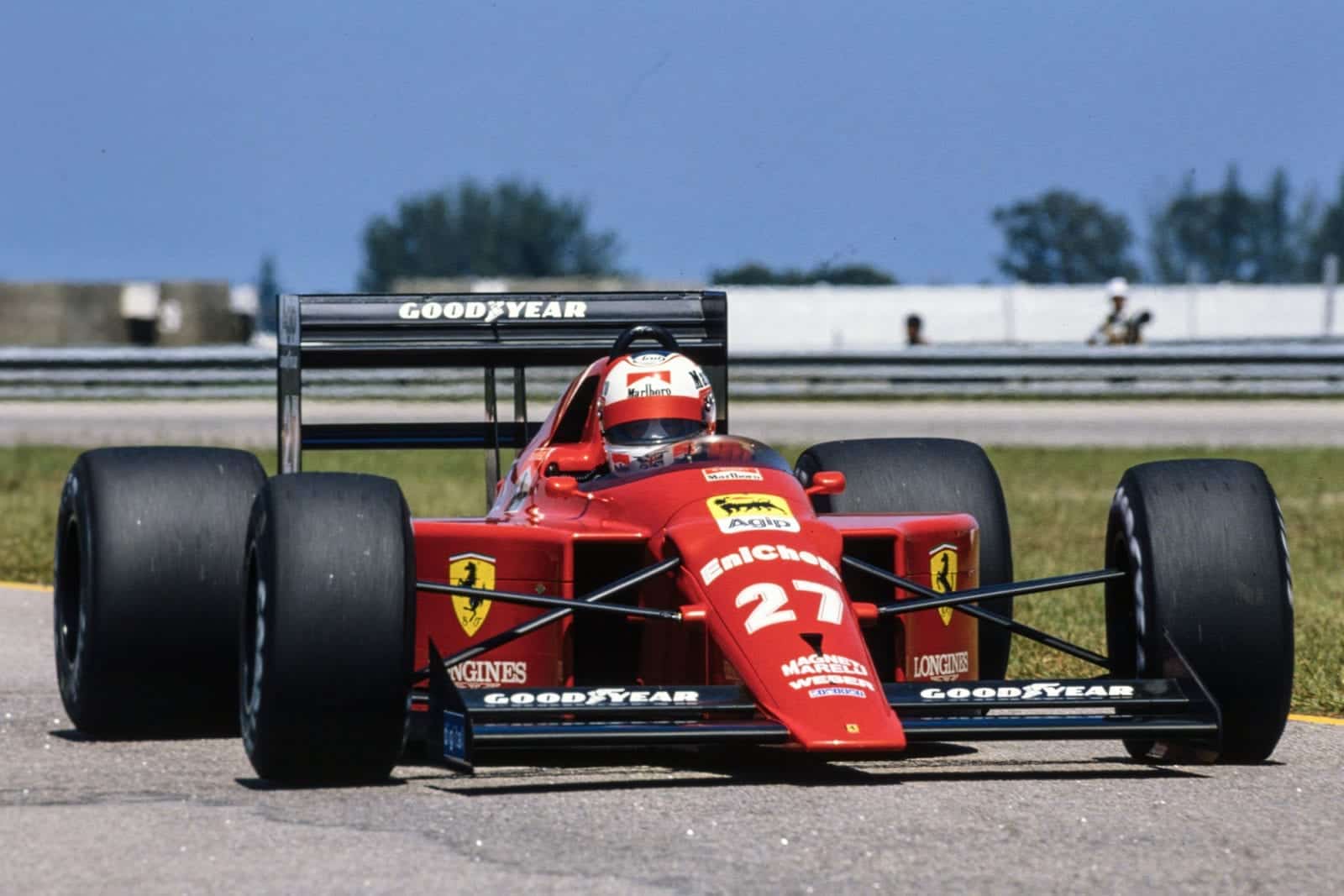
Nigel Mansell was victorious in his first race for Ferrari
Motorsport Images
The pride of Italy
The new breed of atmospheric Formula One cars is the noisiest for many years, yet on the opening lap of the Brazilian Grand Prix it seemed as if you could almost have heard a pin drop. The vocal, patriotic crowd had cheered local hero Ayrton Senna to the echo as he led the field on the warm-up lap, yet he was nowhere to be seen once the race reached the end of the main straight. Incredibly, he had been stymied for the second year in succession.
Riccardo Patrese thus led the first racing lap of the new formula, but if that was a surprise, it was nothing compared to the eventual outcome.
In untimed practice and qualifying Nigel Mansell’s Ferrari Fl/89 had broken in three out of four sessions, its gearbox constantly bedevilled by failure of the hydraulic pump that actuates its superfast semi-automatic change mechanism. Moreover, the story of Ferrari testing throughout the winter months had been one of continual reliability shortcomings, centering on the transmission’s electronics and the V12 engine.
When Mansell popped up in second place after two laps, having spoiled the symmetry of a Canon Williams-Renault 1-2 as Thierry Boutsen shadowed Patrese, the sceptics snorted and prepared to delete car No 27 from their lap charts. Six laps? Well ten maybe. But the Ferrari wouldn’t last much longer.
But it did. Lap after lap Mansell was metronome-precise in his braking and gearshift points, and the five-valve V12 continued its delicious wail. Already, it had firmly given the lie to the other great winter testing story, the myth that it lacked power. Only in February had Mansell diplomatically refused to compare it with a Judd, his clear inference being that the Italian multi-cylinder lacked grunt and was developing only about 580 bhp. Against Honda’s reputed 650 and Renault’s 630, that had looked more than a little sick.
Straightline speeds and overall lap times in qualifying soon told the real story though, and proved that the team’s times from pre-official Rio testing had been kosher. Then Mansell had set what would be the fastest lap — 1min 26.00sec — prior to Senna’s staggering pole dash on the Saturday of race weekend. And Gerhard Berger, in danger of fast becoming overshadowed within the team’s driver priorities, did 1min 26.9sec. When the other teams came the following week, only Senna and Boutsen got close to the Briton’s time.
Qualifying
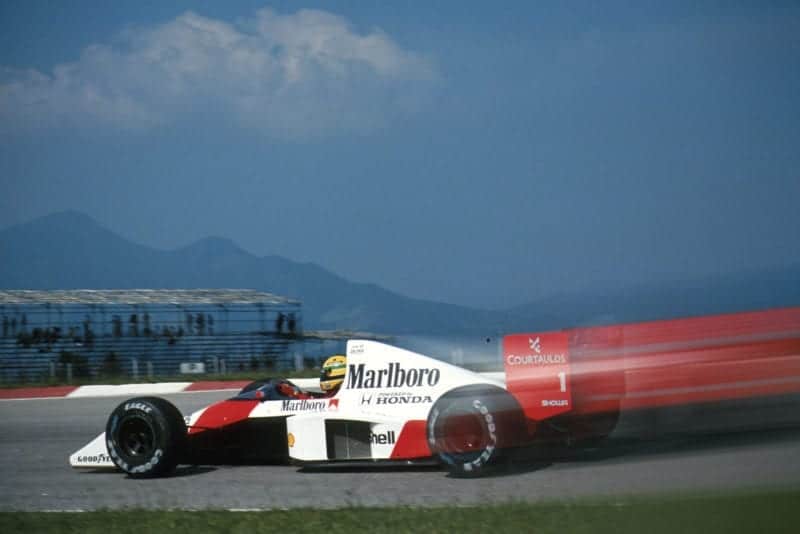
McLaren’s Ayrton Senna was 0.8sec clear in qualifying
Motorsport Images
In official qualifying, too, Berger was right on the pace as the gremlins visited Mansell, with a 1min 26.271sec best that placed him third on the grid. That, however, would ultimately prove unfortunate.
For initial starting purposes John Barnard’s new Ferrari has a conventional clutch to get the car underway, whereupon the driver relies on the hand-operated change levers situated behind the steering wheel. Neither driver was sure how his car would get off the line, but reports suggested the F1/89s had been rocketing away from rest during trials. And so it proved in the heat of competition.
Berger took off superbly and headed directly for the enticing gap between Senna and Patrese on the front row, but as he got there Senna saw the threat and chopped across, so Gerhard went for the right, only to get the same treatment. Instead of lifting he kept his foot in it, and as Patrese began to edge from left to right to take the ideal line and the lead, the biter was bit as Senna became pinched between the Ferrari and the Williams.
“I was trapped, there was nowhere for me to go,” said the Brazilian. “He was trying to intimidate me and I will never lift in that situation,” growled Berger, mindful that once you give in to a driver like Senna he will always remember it.
Contact was inevitable, even though this was a clash between two experienced chargers on the first lap of the first race. The McLaren lost its nose, the Ferrari slithered further on to the grass than it had already been and scraped its belly over the kerb. With damaged nosebox and suspension, Berger was out. Senna survived two stops, the entire nosebox on Neil Oatley’s new MP4/5 being replaced in the second, and two more for tyres, but eleventh place was rather less than a little prudence might have won him.
All of which left Mansell ideally placed to pass Boutsen on lap three and then hound Patrese.
In his 177th Grand Prix, the Italian had electrified observers with a 1min 26.172sec lap in Friday’s qualifying, and survived all that Ferrari and McLaren could throw at him. It was a good augury for the rest of the season, and even if a duff engine scrapped his chances of staying on pole on Saturday, he retained his front-row slot. Senna blistered in two qualifying-tyre laps in the 1min 25sec bracket in that second session as Riccardo calmly watched the Renault and Williams mechanics change the offending V10 in an astonishing 31 minutes, but that effort was diluted when the replacement misfired. From topping Friday’s list, he plummeted to the base of Saturday’s.
His former Williams team-mate was less than delighted with his attempts to retain the lead as the race approached the 15-lap mark, and when Patrese feinted to the left in the left-hander at the end of the main straight, Mansell dodged deftly to the right and slammed past the FW12C on the outside. It was a manoeuvre worth every cuzeros of the inflated ticket price.
Once ahead, it was the old Mansell in command, dealing cannily with traffic and preserving his margin first to Patrese, and then to Alain Prost. Lap by lap the F1/89 beat rhythmically, and even a moment when the steering wheel locking mechanism loosened and gave him a fright at the end of the straight failed to upset his progress. During his second stop all four Goodyears were replaced, and so to the surprise of onlookers was the steering wheel, but thereafter it was plain sailing. After all the months of aggro and testing of the 639 and 640 variants of the car, it had done the business first time out. If the punters were surprised, so were Mansell and Barnard!
“I was stuck on thirteen wins for so long I was beginning to worry,” grinned the relaxed Mansell as he nursed blisters on his hands that had burst as he attempted to pick up his trophy. “I’d like to dedicate this win to the late Enzo Ferrari and to the team, and I’m very happy with the progress we’ve made”.
If the Honda Marlboro McLaren steamroller had thus been halted, there were some valid reasons, and the indications were that either Senna or Prost could have won the race. The Brazilian threw away his chance with the sort of impetuosity that is now a surprise from the man who was so incredible at Suzuka last year. The Frenchman, however, had a more sensible excuse.
Rio has a highly abrasive surface, and where drivers made only one tyre-stop last year when everyone was running the same rubber, this year two were expected thanks to the re-engaged competition between Goodyear and Pirelli.
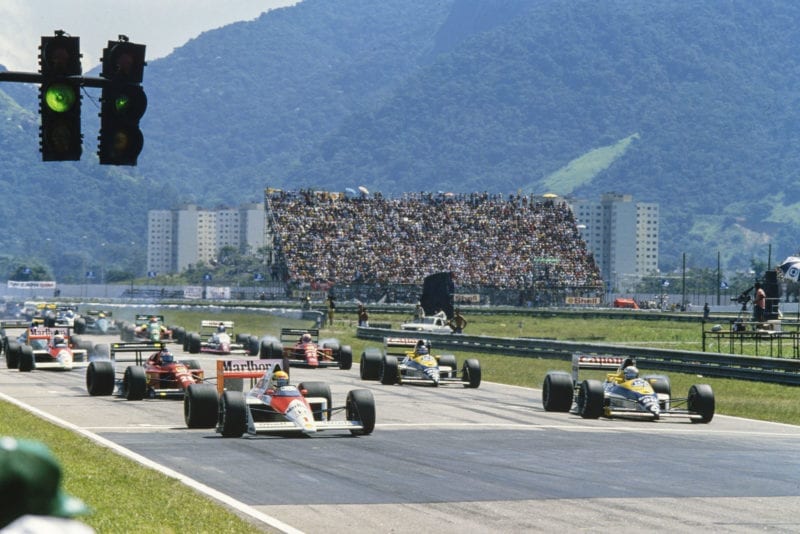
The cars sprint off at the start
Motorsport Images
While Patrese and Williams hoped to make it through with only one, and suffered as a result, Prost was fully intending to make two, and was cunning enough to time his first for lap 15, earlier than most.
However, just prior to it he had begun to detect a problem with his clutch, and this developed to the point where he could no longer use it. Without it he was thus consigned to run the remaining 45 laps on the same tyres.
That set the scene for one of the greatest drives of a glittering career, for with minimal fuss and his own unique blend of speed, precision and gentleness he coaxed that McLaren to the finish. Not only that, but to second place, just 7.809 seconds adrift of Mansell.
“If I had been able to stop for a third set of tyres, I am sure I would have won,” he ventured. It was no idle boast from a beaten racer, either, but a quietly spoken comment from a man who had put in the best drive of the race. The pity of it was that so few people seemed to realise just how good it had been.
The Williams-Renault challenge ultimately came away with nothing, which was rather less than it deserved. Throughout testing, Boutsen had been bang on the pace, and when McLaren’s new MP4/5 arrived late, on the Thursday of the allotted week, its sprint-car oversteer had vexed Senna so much that Prost took over honing it until he finally achieved some semblance of balance. Senna then hacked it round as hard as he could and just pipped Boutsen’s times, but as the Belgian sought to retaliate his rear suspension broke.
Already Philippe Streiff’s accident had cast a pall over affairs and raised questions about the wisdom of the current breed of cars. Now Boutsen’s accident raised more, since it was clearly a component failure. What was most worrying was that Patrick Head’s cars don’t break. “They might loosen the odd wheel in America,” he quipped at the race, in deference to Watkins Glen in 1980, “but they don’t break. The worrying thing is that the corner which broke was the most damaged in the ensuing shunt.”
Boutsen admitted he was feeling a little detuned as Patrese starred in qualifying, but his fourth place on the grid was third once Mansell had overtaken on lap three, and he looked quite comfortable. However, a broken right-hand mirror was evidence of debris damage in the first corner incident and a lap later the Renault cut out on the straight. A piece of Senna’s car had struck his helmet in the incident, and Renault Sport’s Bernard Dudot suspected some might also have entered the overhead air-intake.
Patrese, meanwhile, stayed out too long on his first set of tyres and put himself in the position of having to run really hard to catch up, and the same thing happened on his second set. Nevertheless, he was up to third for a few feet, after setting fastest lap, when a camshaft pulley sheared and forced him to roll to a halt by the pit-wall with ten laps to run.
If Williams was thus unlucky, Leyton House March Racing had something to cheer in the 106deg heat. Like Patrese, Mauricio Gugelmin had been hopeful of making only one stop for tyres, doubting the possibility to make up the 80 or so seconds that two would lose him. However, when he was lying third on lap 37 team manager Ian Phillips ordered him in again. It was a worthwhile move, for though Patrese sneaked ahead for a few yards on lap 52, the Italian’s cam pulley breakage promoted the March again and Mauricio was able to hound Prost to the flag. It was quite the strongest showing of his now year-old Fl career, and a source of delight to the local crowd after Senna’s delay.
Prior to the race, many had fancied Gugelmin’s team-mate Ivan Capelli as a possible victor, the Italian winning the honour of being fastest V8 by a narrow margin from Derek Warwick’s new Arrows and Nelson Piquet’s new Lotus, and fastest 1988 chassis. His race, however, was to come unglued within yards of the start, after a bout of wheel-banging which would lead to rear upright failure on lap 23.
If Prost’s drive was brilliant, Johnny Herbert’s was sensational on his debut. Yet somehow, those who have observed “The Imp” at work in lower formulae saw fourth place as little surprise. He really is that good.
In Rio testing it had been Sandro Nannini who had set the pace for Benetton, but the moment qualifying began it was Herbert who calmly asserted himself, outrunning the Italian in every session. That was so impressive it suggested he was already an F1 regular, not a rookie having his first race since the Brands Hatch shunt in August 1988 which had shattered his ankles …
Still the sceptics predicted he’d wilt in the heat, and one team manager one would have expected to know better even went so far as to say he didn’t think Herbert should be allowed to race! The man himself ignored such comments and provided the sort of response that has become his trademark.
He had to back off at the start and lost a place to Nannini, and when he began to lose ground to the leaders and pitted on lap 12, the detractors prepared to say “I told you so”. But far from being finished, Herbert had cannily refused to become entrapped into trying to keep up, and was the first front-runner to decide on new rubber. It was an outstandingly astute move which Prost was to duplicate shortly after.
By lap 25 it had paid off handsomely as Benetton No 20 was up to third behind the Frenchman and Mansell, and thereafter Nannini never got a sniff of his team-mate. Gugelmin stalked the Briton down and eventually surged ahead for third, but Herbert dogged him to the line. Later, as he slaked a thirst created by a non-functional onboard drink bottle, he admitted that only his neck had been a problem. The ankles? They’d been fine.
Though overshadowed by Herbert, Nannini pressed home for sixth, but sandwiched between them was a Derek Warwick who remained cock-a-hoop about his Arrows A1’s potential. Though his toes were black from having to wear driving boots a size too small — “it’s the only way I can operate the pedals as things are so cramped” — he at least fitted better than team-mate Eddie Cheever.
The lanky American fell foul of FISA’s scrutineers even before first qualifying, since he couldn’t squeeze his frame out of the A1 within the permitted five seconds. Twice he tried on Thursday, and twice it took him seven seconds. By Friday the situation had become acutely embarrassing, as film crews gathered in the Arrows garage to watch his last chance.
He made it, but only just, and once he had been taken out of ninth place after a lap 38 collision with Bernd Schneider, the circulation in his legs was so restricted that they buckled twice as he tried to walk away.
Warwick fared better, though. Where Eddie had nothing but trouble in qualifying, Derek was an ebullient eighth on the grid and had worked his way up to a threatening third when he made his first pit call on lap 19. Alas, it proved a complete disaster as he resumed in eighth place, and though a tigering performance took him back to third by lap 28, a second lengthy stop killed his chances. On both occasions the right rear wheel proved stubborn, “and I didn’t help things by stalling as I pulled away the second time,” he growled in self-admonishment.
By the finish he was up to fifth, but a baulky gear-linkage which made fourth and fifth tricky to select prevented him closing to challenge Herbert and Gugelmin. But for those stops, which probably cost him around 18 seconds in all, he would certainly have been significantly better placed. Second had been a definite possibility, but Jack Oliver felt Arrows had lost the chance of its first victory. By the flag, Derek was 17.866 seconds adrift of Mansell…
If one Arrows at least scored some points after its qualifying promise, Camel Team Lotus was to be less fortunate with its new 101. In the morning warm-up Nelson Piquet had ground to a halt after a lap and a half with fuel-pump drive failure, and from the start the replacement gave trouble as the pressure began to fall. By lap 11 the former champion’s race was over, and while Satoru Nakajima survived for eighth, his was hardly a scintillating meeting as it included a brace of over-revved Judds from an expensive qualifying which netted him only 21st on the grid.
Jonathan Palmer and Michele Alboreto went to Rio prepared for the worst in the updated Tyrrell 017Bs, since Harvey Postlethwaite’s new 018 wouldn’t be ready in time. Surprisingly, though, JP brought his home a sterling seventh after qualifying problems led to guesstimated race settings, and a front brake duct fell off. “It didn’t affect the brakes so much as the car’s balance,” he revealed. “But the biggest scare was when it came off and tore past my head at 170 mph!.
There was also the little matter of one of the dual throttle-return springs breaking. Had the other broken too the throttle would have jammed open, but Palmer shrugged it off laconically. “If it was qualifying I’d have stopped, but you don’t come in for a little thing like that in a race, do you?.
On his re-acquaintance with Uncle Ken’s team, Alboreto had nothing but problems. The 0170 uses the 018’s new gearbox, where the ratios are located ahead of the axle-line. However, the 017B’s tub is so much wider that it created a very sharp angle for the linkage. With his driving position Michele couldn’t change gear properly all weekend. He finally managed tenth place, with a cracked exhaust to add to his troubles, and nobody was imprudent enough to solicit his views on the success of car No 27!
Rio also marked the return of Brabham, and an auspicious comeback it was to prove. Both Martin Brundle and Stefano Modena were obliged to pre-qualify, but it was a formality, a breeze, as they topped the timesheets. In fact, the cooler — if you can call 101° cool — conditions on Friday morning suited the Sergio Rinland-designed BT58s perfectly on their Pirelli rubber, and during the morning untimed practice sessions the cars were also very competitive. At one stage Senna and Brundle vied for fastest time, just as they did in their Formula Three days in 1983.
However, as the temperatures sidled up to 106° each afternoon, so the Pirellis reacted badly. From fine balance the Brabhams slipped into unpredictable behaviour as the drivers chased their tails. On the surface, Pirelli had done lots of research mileage with Minardi and Dallara during the winter, but in Rio at least it transpired that their CD19 and CD25 compound radials were exactly the same as those on which Gerhard Berger had won the 1986 Mexican Grand Prix, so something is awry somewhere.
Brundle and Modena thus started alongside one another on the seventh row. In the race they were separated by Andrea de Cesaris in the sole Scuderia Italia Dallara (the unfortunate Alex Caffi was prevented from pre-qualifying his by fuel-pump maladies). On his Pirellis the Italian was charging as usual, and occupied a healthy tenth place which became ninth when Brundle was obliged to pit early on lap 10.
Martin had been hoping to eke out his tyres for 25 laps, but debris from the first-corner incident had damaged his nose wings and induced understeer. He returned to the fray but was thwarted by electrical failure, while Modena’s race ended when a cv joint leaked away its grease and eventually seized. Nevertheless, Brabham made a solid impression, and will do better still given further tyre development by Pirelli.
Dallara, too, lived up to its off-season form, until the seventh-placed de Cesaris ground to a halt with fuel-pump failure with four laps left. He was classified 13th. That was rather better than Minardi managed.
The Faenza team’s weekend got off to a bad start when Pier-Luigi Martini’s Friday times were disallowed because his head broke the imaginary line from the two cockpit rollover hoops during a FISA spotcheck, but he did well enough on Saturday to qualify 16th. Within three laps he was out, though, after the team went too far on lightening its interim M188B and suffered a broken lower engine-mount as a result. That merely compounded the misery of team-mate Luis Sala retiring at the first corner after he ran into the back of a slowing Olivier Grouillard.
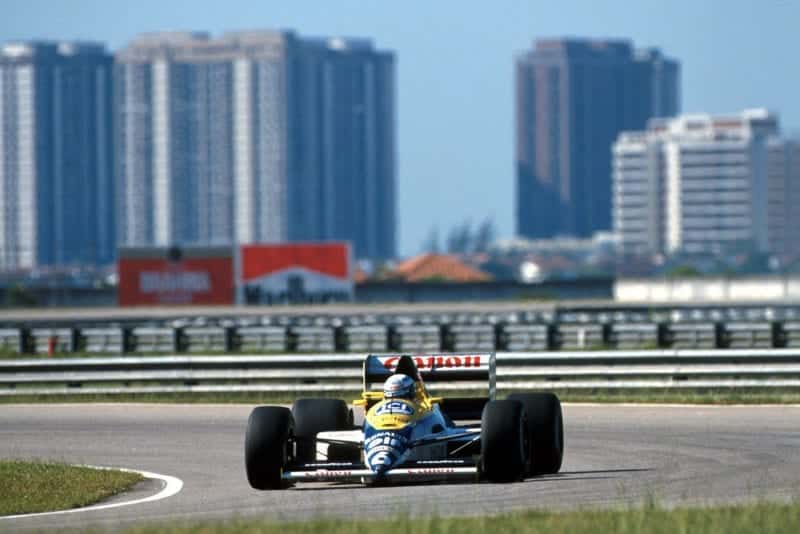
Riccardo Patrese set fastest lap yet failed to finish
Motorsport Images
The Ligier rookie was the sole representative of the French team as Rene Arnoux’s new JS33 had a peculiar handling imbalance that prevented him qualifying. He too had fallen foul of FISA’s head-height check on Friday, and as usual had brought his rivals to apoplexy with his selfish driving tactics. At one stage Prost, Brundle and Warwick were all interrupted, Brundle actually having to spin at 150 mph to avoid him, while Cheever became positively bugeyed whenever his name was mentioned after receiving a couple of very rude chops.
Grouillard had had a momentary problem with a sticking throttle, which was why he braked sharply for the first corner and was collected by the unfortunate Sala, but once it cured itself he drove cleanly to ninth in a sensible debut.
In this first race of the new formula, fortunes in other camps had picked up little since 1988, despite the efforts each team had made over the winter.
Zakspeed had produced two very neat Gustav Brunner-designed 891s for Bernd Schneider and Aguri Suzuki, but they lost seven Yamaha V8s in testing. That put them on the wrong foot immediately, and then Suzuki failed to pre-qualify when his transmission broke its input shaft, Schneider then lost a couple more engines in qualifying but did well to serape in. He was running a lap down when his right front suspension collapsed at the end of the main straight and the ensuing incident brought him into contact with the blameless Cheever. Both were put out.
Osella was back to two-car strength, with Piercarlo Ghinzani joining Nicola Larini, but like Suzuki, Ghinzie didn’t make it past pre-qualifying. Larini did, however, and got into the race too, only to be black-flagged for starting in the wrong position. All he had done was follow the instructions of the man holding his grid board, so a CART-style stop-and-go penalty would have been apposite than disqualification.
Lola had run out of time to ready its LC89, even though it had been launched in the Monday before the race, mainly the failure of Lola’s Formula 3000 car in a crash test had delayed all of its programmes. Philippe Alliot and Dalmas thus had to rely on the LC88D with the screaming Lamborghini V12 installed.
Dalmas failed to qualify and the car was awful, but Alliot was delighted with Forghieri’s new engine, and couldn’t believe he had made it home twelfth after a knife-edge drive. Only weeks before, team partner Didier Calmels had shot his wife to death in Paris, so any consolation was worth something to Gerard Larrousse’s team.
There was to be no consolation for AGS, for Philippe Streiff’s testing accident, Henri Julien elected not to run replacement Gabriele Tarquini in the JH23B until Imola, so rookie Joachim Winklehock was the Gonfaron team’s sole representative. After electrical problems he joined the too-new Onyx ORE-1s of Stefan Johansson and Bertrand Gachot, and Pierre-Henri Raphanel’s Coloni in the ranks of those failed to pre-qualify.
Fellow rookie Volker Weidler didn’t make it in his Rial 189 after engine failure, but Formula One returnee Christian Danner had his in 14th and last place in the race after delay to check the rear suspension, only to have the crownwheel and pinion fail five with laps to run. He was still classified 14th.
Last year’s F3000 sparring Roberto Moreno and Gregor Foitek make the grid. The Champion’s Coloni was a clear handful and an ignition problem killed his chances, Foitek was a surprise third in pre-qualifying after a dramatic exhibition of brinkmanship in the updated EuroBrun. An engine failure early on Saturday afternoon left him with no chance of a race.
If the fortunes at the tail of the grid reflected little change since 1988, however the return to force of Ferrari and Williams had Honda Marlboro McLaren thinking hard as the teams headed back to Europe. Certainly, the pace of the Williams had been expected after testing, but Ferrari’s reliability and speed had been a major surprise.
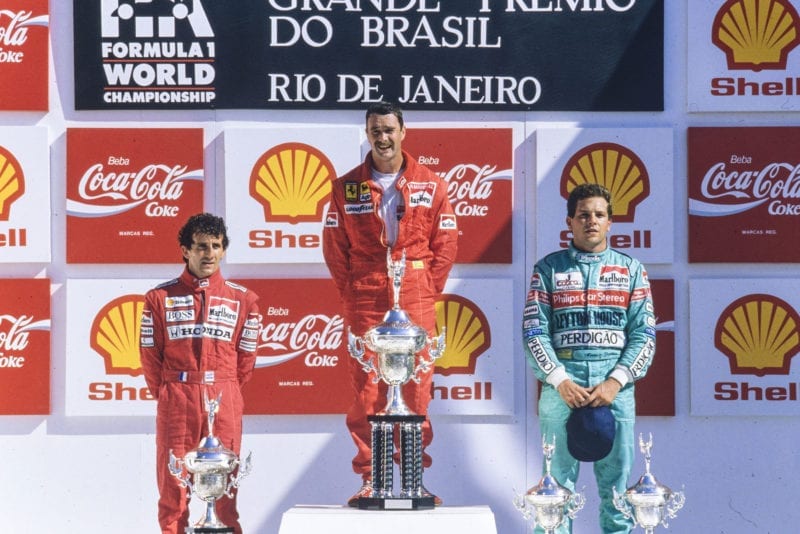
Mansell shows both his joy and fatigue on the podium
Motorsport Images
McLaren should have won. It had the pace to, and if one of its drivers had been mechanically handicapped, the other should have been able to come up with the goods. But that was small consolation to Ron Dennis as he dismissed Senna’s with the comment that “boys will be boys”. While the rest of the paddock celebrated apparent change in the status quo, a superb race and the birth of a new star, the fact remained that one of those boys had ruined the McLaren boss’s dream of winning every Grand Prix in a season.
